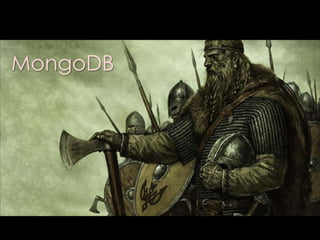Mongodb open data day 2014
- 1. MongoDB
- 2. AGENDA ŌĆó Introduction ŌĆó NoSQL ŌĆó MongoDB ŌĆó Concepts/Fundamentals ŌĆó Working with MongoDB (hands-on)
- 3. WHO AM I? ŌĆó Software Developer/Architect/Consultant for 15 years. ŌĆó Working in the .NET stack (mainly in the web space) since 2001. ŌĆó Started getting interested in MongoDB about 2-3 years ago. David Green @davidjeet about.me/davidgreen24
- 4. WHERE DOES THIS TALK FIT IN?
- 5. CLASSIC N-TIER ARCHITECTURE User Interface (UI) Business Layer/Service You Are Here Data Layer
- 6. AGENDA ŌĆó Introduction ŌĆó NoSQL ŌĆó MongoDB ŌĆó Concepts/Fundamentals ŌĆó Working with MongoDB (hands-on)
- 8. All Databases Relational Databases (Oracle, mySQL, Postgres, SQL Server) NoSQL (MongoDB, Redis, Neo4J, Cassandra, Hbase)
- 9. What is NoSQL? Martin Fowler: Some characteristics are common amongst these databases, but none are definitional. Model not using the SQL language) Designed to run on large clusters Not using the relational model Open source No schema enforced
- 10. NoSQL Database Families* Key-value Columnar ŌĆó HBase ŌĆó Cassandra ŌĆó Hypertable Document ŌĆó MongoDB ŌĆó CouchDB ŌĆó RavenDB ŌĆó ŌĆó ŌĆó ŌĆó Redis Riak Memcached Voldemort Graph ŌĆó Neo4J ŌĆó GiraffeDB ŌĆó InfiniteGraph * ŌĆ£Seven Databases in Seven WeeksŌĆØ, Eric Redmond and Jim R. Wilson
- 13. WHO USES THIS NOSQL STUFF?
- 15. AGENDA ŌĆó Introduction ŌĆó NoSQL ŌĆó MongoDB ŌĆó Concepts/Fundamentals ŌĆó Working with MongoDB (hands-on)
- 16. WHAT IS MONGODB?
- 17. WHAT IS MONGODB? Open source NoSQL database Documentoriented Stores JSON-like documents (dynamic schemas) Includes a strong query language (Javascript) Powerful, flexible indexing (including geospatial) Sharding and replication Cross-Platform (many drivers ŌĆō e.g. C#, Java, Python, Ruby)
- 18. Why MongoDB? 1. Open Source - no licensing fees. 2. Relatively developer friendly and easy to ramp up. 3. Fast reads.
- 19. MongoDB Search Trends ŌĆō Google
- 20. WHEN NOT TO USE MONGODB When one or more of the following are insurmountable even after modeling: ŌĆó Relationships/Join ŌĆó Transactions ŌĆó Write Safety (High volume of writes/sec. scenarios)
- 21. AGENDA ŌĆó Introduction ŌĆó NoSQL ŌĆó MongoDB ŌĆó Concepts/Fundamentals ŌĆó Working with MongoDB (hands-on)
- 23. 10GEN QUICK REFERENCE CARD
- 24. MONGODB - JSON & BSON ’é¦ JSON ’āś Number ’āś String ’āś Boolean ’āś Array ’āś Object ’āś null ’é¦ BSON = JSON + ’āś ’āś DateTime ’āś Byte Arrays ’āś GeoSpatial
- 25. EXAMPLE BSON DOCUMENT { } "_id" : ObjectId("5218282429f4a04648f64870"), "Title": "What's new in MongoDB 2.4", "Content" : "MongoDB 2.4 represents hundreds of improvements and features driven by user requests...", "Author" : { "FirstName" : "David", "LastName" : "Green" }, "CreatedOn" : ISODate("2013-07-19T01:30:52Z"), "LastModifiedOn" : ISODate("2013-08-24T03:27:32Z"), "Comments" : [], "Tags" : [ ŌĆØDatabases", ŌĆØFeatures", "NoSQL", "MongoDB" ]
- 26. INSTALLING MONGO
- 27. MONGODB DATABASE INSTALL Starting Up the Server
- 29. AGENDA ŌĆó Introduction ŌĆó NoSQL ŌĆó MongoDB ŌĆó Concepts/Fundamentals ŌĆó Working with MongoDB (hands-on)
- 31. THE END

























![EXAMPLE BSON DOCUMENT
{
}
"_id" : ObjectId("5218282429f4a04648f64870"),
"Title": "What's new in MongoDB 2.4",
"Content" : "MongoDB 2.4 represents hundreds of
improvements and features driven by user
requests...",
"Author" : {
"FirstName" : "David",
"LastName" : "Green"
},
"CreatedOn" : ISODate("2013-07-19T01:30:52Z"),
"LastModifiedOn" : ISODate("2013-08-24T03:27:32Z"),
"Comments" : [],
"Tags" : [
ŌĆØDatabases",
ŌĆØFeatures",
"NoSQL",
"MongoDB"
]](https://image.slidesharecdn.com/mongodbopendataday2014-140305082807-phpapp01/85/Mongodb-open-data-day-2014-25-320.jpg)





